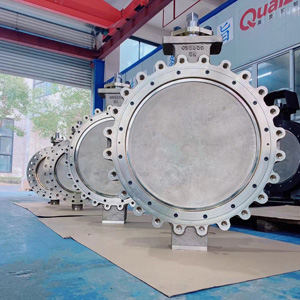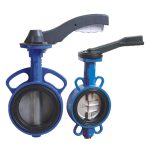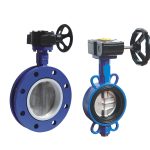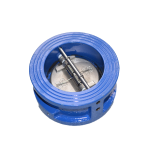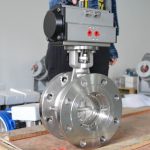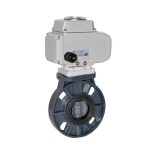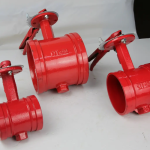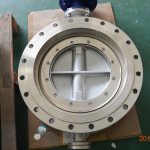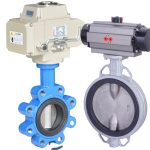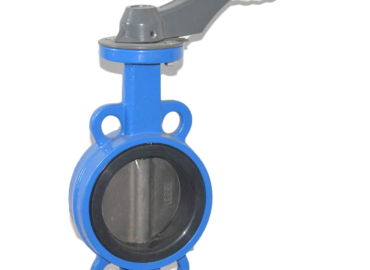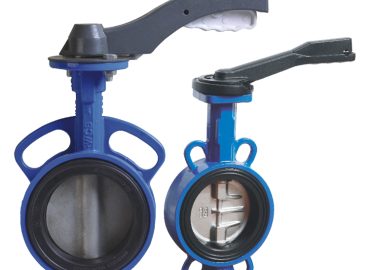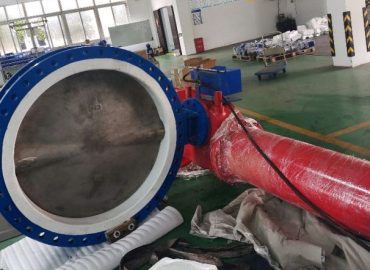Butterfly valves, a crucial component in many industrial applications, come in various types, each designed to meet specific needs. Among these, lug vs wafer butterfly valve stand out due to their unique advantages. This post will delve into the benefits of using these two types of butterfly valves, discussing their design, operation, and the distinct advantages they offer. Whether you’re looking for durability, ease of installation, cost-effectiveness, or versatility, understanding the benefits of lug and wafer butterfly valves can guide you to make an informed decision for your specific requirements.
Introduction
Butterfly valves, known for their simplistic design and efficiency, are widely used in various industries for regulating and isolating flow in systems. Among the diverse types of butterfly valves, lug vs wafer butterfly valve are particularly popular due to their unique advantages. Lug butterfly valves are renowned for their ease of installation and robust design. They are sandwiched between flanges using a separate set of bolts for each flange, which allows either side of the piping system to be disconnected without affecting the other side. This makes them ideal for systems that require regular maintenance or inspection. Additionally, they are highly durable, making them an economical choice over time, despite their higher initial cost. On the other hand, wafer butterfly valves are appreciated for their compact and lightweight design. They are held in place between two pipe flanges by bolts that pass through the flanges and are tightened to compress the valve. Their design makes them a perfect fit for tight spaces where larger valves won’t fit. They are also generally more affordable upfront than other types of valves, making them a cost-effective solution for many applications. Furthermore, they require very little maintenance, which can lead to significant savings in the long run. Both lug and wafer butterfly valves offer significant advantages depending on your specific needs, making them a valuable addition to many industrial applications.
Brief introduction to butterfly valves.
Butterfly valves are a type of flow control device, commonly utilized in various industrial applications. They operate by using a disc, which rotates on a central axis inside a pipe to control fluid flow. When the disc is turned such that it aligns fully with the flow, the valve is in open position and allows passage of fluid. Conversely, when the disc is rotated to a position perpendicular to the flow, the valve is closed, thus blocking the fluid passage. Butterfly valves are celebrated for their simplicity, reliability, and cost-effectiveness. Their design allows for quick shutoff, making them an excellent choice for systems that require both isolation and throttling capabilities.
Explanation of the focus of the blog post: lug vs wafer butterfly valve.
The focus of this blog post is to delve into the specifics of lug vs wafer butterfly valve, two prevalent types within the broader category of butterfly valves. Both lug vs wafer butterfly valve have unique characteristics that make them suitable for different applications, and understanding these can help in making informed decisions when selecting valves for specific uses. We’ll be exploring their design, how they function, and most importantly, the distinct advantages they offer. Whether you’re dealing with systems that require frequent maintenance or operating in tight spaces, gaining insights into these two types of butterfly valves will provide valuable guidance.
Understanding Butterfly Valves
Butterfly valves are an integral part of flow control systems across various industries, from oil and gas to water treatment, and even in everyday household plumbing. They are quarter-turn rotational motion valves that use a disc-shaped closing mechanism, which rotates on its axis to regulate the flow of fluids. When the disc is positioned parallel to the fluid flow, the valve is fully open and allows maximum flow. Conversely, when the disc is rotated by 90 degrees such that it’s perpendicular to the flow, the valve is fully closed, obstructing all fluid flow. The simplicity of this operation, combined with the compact and lightweight design of butterfly valves, makes them a preferred choice for many applications. Their design also facilitates quick shutoff, and they require less material to construct than other valve types, making them a cost-effective option. Furthermore, butterfly valves are versatile, capable of handling a wide range of temperatures and pressures, and can be used with many different types of fluids, including water, oil, and gas. They can also be equipped with manual handles or automated actuation systems, depending on the specific application requirements.

Basic explanation of what butterfly valves are and how they function.
Butterfly valves are flow control devices used in various industrial systems to regulate or halt the flow of fluids. They consist of a disc, often circular or slightly oblong, which is pivotally mounted within a pipe. This disc is attached to an actuator outside of the pipe which, when turned, rotates the disc either parallel or perpendicular to the flow. In the parallel position, the disc allows fluid to flow freely through the pipe. When rotated 90 degrees to a perpendicular position, the disc blocks the pipe, stopping the flow entirely. This simple mechanism of operation, which requires only a quarter turn to go from fully open to fully closed, makes butterfly valves highly efficient and easy to use.
Discussion of the common uses of butterfly valves in various industries.
Butterfly valves are versatile devices with a broad range of applications across various industries. In the oil and gas industry, they are often used for isolating and regulating flow due to their quick shutoff capabilities. In water treatment plants, butterfly valves are commonly used to control water flow, thanks to their ability to handle varying pressure levels and large volumes of fluid. The food and beverage industry also utilizes sanitary butterfly valves for their easy-to-clean design, which helps maintain hygiene standards. In HVAC systems, these valves are used to control the flow of hot and cold air. Additionally, butterfly valves find use in fire protection systems, where they control the flow of water in sprinkler systems. Their compact design, cost-effectiveness, and efficient operation make butterfly valves an essential component in many industrial processes.
Lug Butterfly Valves
Lug butterfly valves are a specific type of butterfly valve that is designed with features tailored for more demanding applications. The defining characteristic of a lug butterfly valve is its mounting system. Unlike other butterfly valve types, lug butterfly valves have threaded inserts at both sides of the valve body. This allows them to be installed into a system using two sets of bolts and nuts, without the need for nuts on the other side. Because of this feature, lug butterfly valves can be used in situations where a pipe needs to be disconnected without interrupting the system’s flow or pressure. This makes them an ideal choice for flanged ends that might need to be separated at some point. Furthermore, lug butterfly valves are known for their durability and strength, which allows them to handle higher pressure and temperature levels compared to other valve types. They are frequently used in applications where dead-end service is required, such as industrial processing, chemical plants, and water treatment facilities. Despite their slightly higher initial cost, their robustness, longevity, and ease of maintenance make lug butterfly valves a cost-effective solution over time.
Detailed description of lug butterfly valves, their design, and operation.
Lug butterfly valves are a specialized type of butterfly valve recognized for their unique design and robust operation. They are constructed with threaded inserts on both sides of the valve body, allowing them to be sandwiched between two flanges using separate sets of bolts for each flange. This design enables the valve to handle pressure from both directions, allowing downstream piping to be disconnected without disrupting the upstream side. The operation of lug butterfly valves is similar to other butterfly valves — a disc is rotated within the pipeline to control fluid flow. When the disc aligns with the flow, the valve is in the open position, whereas when the disc is perpendicular to the flow, the valve is closed. Lug butterfly valves are highly durable and can withstand high pressure and temperature conditions, making them suitable for rigorous industrial applications such as chemical processing, power generation, and water treatment.
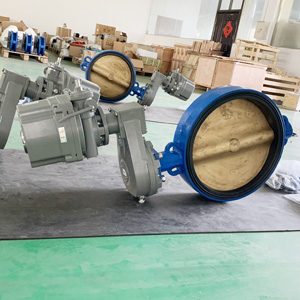
Explanation of where and why lug butterfly valves are typically used.
Lug butterfly valve are typically used in systems where the flow may need to be shut off at different points, and where the disassembly of certain parts of the system without interrupting the flow is necessary. Their unique design allows them to be mounted between two flanges, and one side can be detached without affecting the other. This makes them ideal for applications that require regular maintenance or system modifications. Additionally, due to their robust construction, lug butterfly valves are often used in high-pressure and high-temperature environments, such as power plants and chemical processing facilities. They’re also commonly used in water treatment plants and fire protection systems. The ability to withstand demanding conditions while providing efficient flow control makes lug butterfly valves a popular choice in many industrial applications.
Wafer Butterfly Valves
Wafer butterfly valves, a type of butterfly valve, are named for their thin, wafer-like design. They are sandwiched between two flanges in a piping system and typically held in place using long bolts that pass through the entire assembly. This compact and lightweight design makes wafer butterfly valves particularly suitable for space and weight-sensitive applications. Despite their simplicity, wafer butterfly valves offer efficient flow control in low to medium pressure applications. The disc inside the valve rotates with the turning of the handle, allowing for quick opening and closing operations, making it ideal for systems that require frequent cycling. The disc’s rotation can also be adjusted to modulate flow, providing a certain level of flow control accuracy. However, it’s worth noting that they may not provide as precise control as some other valve types. Wafer butterfly valves are commonly used in a wide range of industries, including water distribution, chemical processing, power generation, and HVAC systems. Their construction materials can vary, from stainless steel to PVC, to cater to different fluid handling needs and resist various levels of corrosive or abrasive fluids. Despite their many advantages, it’s essential to remember that wafer butterfly valves have limitations. They are generally not suitable for high-pressure, high-temperature applications, and their sealing is not as tight as some other valve types, potentially leading to minor leakage.
Detailed description of wafer butterfly valves, their design, and operation.
Wafer butterfly valves are a specific type of pneumatic butterfly valve known for their compact, wafer-like design. Constructed to fit between two pipe flanges, these valves are typically secured with long bolts that span the entire assembly, effectively sandwiching the valve in place. The primary component of a wafer butterfly valve is a circular disc, which is positioned in the center of the pipe and connected to an actuator outside of the valve. The actuator rotates the disc, either parallel or perpendicular to the fluid flow, to open or close the valve. When the disc is turned so that it’s parallel to the fluid flow, the valve is fully open, allowing unrestricted flow. Conversely, when the disc is rotated so that it’s perpendicular to the flow, the valve is closed, stopping the fluid passage. This simple quarter-turn operation allows for quick and efficient control of the flow rate. Given their design, wafer butterfly valves are particularly suited to systems where space is at a premium due to their compact size and lightweight nature. They’re commonly used in various industries such as water treatment, HVAC, and power generation. However, they generally aren’t suitable for high-pressure and high-temperature applications, and their seal may not be as tight as other types of valves, which could lead to potential leakage.
Explanation of where and why wafer butterfly valves are typically used.
Wafer butterfly valves are typically used in systems where space and weight considerations are important due to their thin, compact design. They’re often found in low-pressure applications with high flow rates such as water distribution, cooling systems, and chemical processing plants. The quarter-turn operation of wafer butterfly valves allows for rapid opening and closing, making them suitable for applications that require frequent cycling. Additionally, their simple construction requires less maintenance, which can result in lower operating costs. However, they may not provide a perfect seal, so they are generally not recommended for applications where minor leakage could be problematic. Their design is also not suited for handling viscous fluids or slurry, as the disc inside the valve could be impeded by such substances.
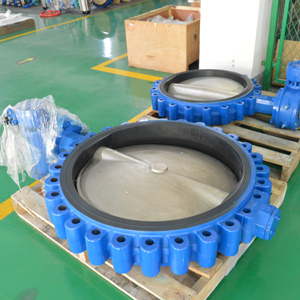
Advantages of Using Lug Butterfly Valves
Lug butterfly valves have several advantages that make them a preferred choice for many industrial applications. Firstly, they are known for their robust design which can handle higher pressure systems compared to wafer-style butterfly valves. Lug butterfly valves have threaded inserts at both sides of the valve body which allows them to be installed into a system using two sets of bolts and no nuts. This means they can be connected to pipes on either side, allowing for one side of the pipe system to be disconnected without affecting the other. This feature makes lug butterfly valves ideal for situations where regular system maintenance or inspection is required as it allows for easy isolation of different parts of the pipeline. They also offer the flexibility of being used as end-of-line valves, which can be beneficial in scenarios where downstream piping removal or repair is necessary. Furthermore, lug butterfly valves provide a tight seal, making them suitable for applications that require zero leakage. Despite their sturdy construction, they maintain the benefits of butterfly valves in general, such as quick operation due to their quarter-turn design, simplicity, and cost-effectiveness. These factors combined make lug butterfly valves a versatile and reliable option for various fluid control applications.
Ease of installation
One of the significant advantages of many valve types, including butterfly and plug valves, is their ease of installation. Butterfly valves, for example, are lightweight and compact, which makes them relatively easy to handle during installation. They can be installed between flanges using a minimal number of bolts, reducing the time and effort required for installation. Plug valves, while heavier and more complex, often come with detailed installation guides that make the process straightforward. Lug butterfly valves, in particular, stand out for their installation convenience. Their design allows them to be sandwiched between two flanges using a set of bolts, facilitating easy installation and removal without disturbing the adjoining piping system. This feature not only simplifies the installation process but also makes maintenance tasks easier and more efficient, contributing to reduced downtime and increased productivity in many industrial applications.
Durability and strength
Durability and strength are key factors to consider when choosing valves for industrial applications. Butterfly valves, particularly those made from robust materials like stainless steel or cast iron, are known for their durability. Their simple design has fewer moving parts, which reduces the likelihood of mechanical failure, contributing to their longevity. Lug butterfly valves, with their more robust construction, are able to withstand higher pressure systems, adding to their strength and durability. Plug valves, on the other hand, are known for their incredible strength. They are designed to handle high pressure and extreme temperatures, making them suitable for challenging environments. The body of a plug valve is typically made of strong and corrosion-resistant materials, which increases its lifespan. However, due to their complex design, they may require more maintenance to ensure their longevity. Regardless of the type, the durability and strength of a valve largely depend on the quality of its construction and the material used, making these critical considerations during selection.
Versatility in various applications
The versatility of both butterfly and plug valves makes them suitable for a wide range of applications. Butterfly valves, for example, are commonly used in water distribution systems, HVAC systems, and chemical processing plants due to their ability to handle large flow rates and low-pressure drops. Their compact design also makes them ideal for applications where space is limited. Lug butterfly valves, in particular, offer increased flexibility as they can be used as end-of-line valves, allowing for easy isolation and maintenance of different parts of a piping system. On the other hand, plug valves are known for their ability to handle high pressure and viscous fluids, making them ideal for applications in oil and gas industries, power plants, and wastewater management. The versatility of these valves extends to their compatibility with manual, electric, or pneumatic actuators, providing options to suit various operational needs. This wide range of potential uses underscores the versatility of these valves in different industrial environments.
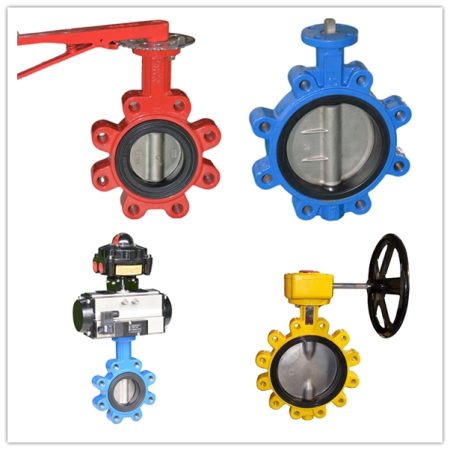
Cost-effectiveness over time
When considering the cost-effectiveness of valves, it’s important to look beyond the initial purchase price and take into account factors like installation costs, maintenance expenses, and the valve’s lifespan. Butterfly valves, for instance, are often more affordable upfront due to their simple design and fewer components. Their ease of installation and low maintenance needs can further reduce costs over time. In addition, their durability and long service life contribute to their overall cost-effectiveness. Plug valves may have a higher initial cost due to their complex design and robust construction. However, their ability to handle high-pressure systems and harsh conditions can result in less downtime and fewer replacements, potentially saving money in the long run. Lug butterfly valves, with their ability to isolate parts of a system for maintenance or repair without shutting down the entire operation, can also lead to significant cost savings in terms of reduced operational disruptions. Therefore, while the initial cost is a factor, the long-term cost-effectiveness of a valve largely depends on its suitability for the specific application, its durability, and maintenance requirements.
Advantages of Using Wafer Butterfly Valves
Wafer butterfly valves offer several advantages that make them a popular choice in various industries. Their compact and lightweight design makes them ideal for systems where space is a concern. They are relatively easy to install and require less support structure compared to other types of valves, resulting in lower installation costs. The quarter-turn operation of wafer butterfly valves allows for quick opening and closing, making them suitable for applications requiring frequent operation or emergency shut-offs. Moreover, their simple construction with fewer moving parts results in lower maintenance needs, which can lead to significant cost savings over time. However, it’s important to note that while wafer butterfly valves can handle a wide range of temperatures and pressures, they may not provide a perfect seal under high-pressure conditions. Thus, they are best suited for low to medium pressure applications. Nonetheless, their affordability, ease of operation, and low maintenance requirements make wafer butterfly valves a cost-effective choice for many fluid control systems.
Compact and lightweight design
The compact and lightweight design of many valves, particularly electric butterfly valve, offers several advantages in industrial applications. This design allows for easy handling and installation, reducing the time and labor costs associated with these tasks. Due to their small footprint, butterfly valves are ideal for systems where space is a concern, such as in HVAC systems or water treatment plants. Their lightweight nature also means they require less support structure compared to heavier valve types, which can lead to significant cost savings in terms of materials and installation. Moreover, the compact design of these valves doesn’t compromise their functionality or performance. They can handle large flow rates and offer quick operation due to their quarter-turn design. This combination of compactness, lightness, and high performance makes these valves a versatile and convenient choice for various fluid control applications.
Simplicity in operation
One of the key advantages of many types of valves is their simplicity in operation. Butterfly valves, for example, have a quarter-turn operation, which makes them easy to open and close quickly in response to changes in fluid flow rates. This simplicity in operation makes butterfly valves ideal for applications requiring frequent operation or emergency shut-offs. Additionally, the simple design of these valves with fewer moving parts means they require less maintenance than other valve types, leading to cost savings over time. Plug valves also offer ease of operation with their quarter-turn operation. Moreover, their simple design with a rotating plug that moves in and out of the valve body allows for efficient flow control. The simplicity of these valves in operation also reduces the risk of operational errors, making them a reliable choice for critical applications. Overall, the simplicity of operation in various valves contributes to their ease of use, efficiency, and overall effectiveness in fluid control systems.
Low maintenance requirements
Low maintenance requirements are a significant advantage of many valves, contributing to their overall cost-effectiveness and operational efficiency. Butterfly valves, for instance, have a simple design with fewer moving parts, which reduces the likelihood of mechanical failures and the need for regular maintenance. Plus, their corrosion-resistant materials can withstand harsh conditions, further minimizing maintenance needs. Similarly, plug valves, with their robust construction and self-lubricating features, require minimal maintenance, even in high-pressure and high-temperature applications. Lug butterfly valves, with their ability to isolate parts of a system, allow for maintenance or repair of specific sections without shutting down the entire operation, minimizing downtime and maintenance costs. Overall, these low maintenance requirements save time and resources, enhance operational efficiency, and prolong the lifespan of the valves, making them a cost-effective solution for various fluid control applications.
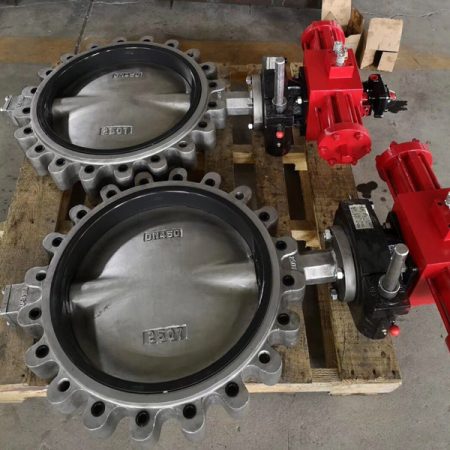
Economical upfront costs
Economical upfront costs are a significant advantage of many valves, contributing to their affordability and accessibility in various industries. Wafer butterfly valves, for example, have a simple design with fewer components, making them relatively affordable compared to other valve types. Their lightweight construction also reduces shipping and installation costs, making them an economical choice for fluid control systems. Ball valves offer similar cost advantages with their simple design and straightforward construction. They are typically less expensive than gate valves or globe valves, which require more complex manufacturing processes. However, it’s important to note that while economical upfront costs can be attractive, the overall cost-effectiveness of a valve depends on its suitability for the specific application, its durability, and maintenance requirements. Therefore, it’s essential to consider all relevant factors when selecting a valve for a fluid control system.
Comparing Lug vs Wafer Butterfly Valve
Lug and wafer butterfly valves are two popular types of butterfly valves used in fluid control systems. While they perform similar functions, they have some key differences. Wafer butterfly valves are designed to fit between two flanges and are held in place by bolts. This design makes them easier to install and remove compared to lug butterfly valves, which require additional bolts on each flange to secure them in place. Additionally, wafer butterfly valves are typically less expensive than lug butterfly valves due to their simpler design. However, lug butterfly valves offer better support and stability in high-pressure applications due to their additional bolts, making them a more reliable choice for critical operations. Moreover, lug butterfly valves allow for maintenance or repair of specific sections without shutting down the entire operation, adding to their versatility. Ultimately, the choice between lug and wafer butterfly valves depends on the specific application requirements, including pressure, temperature, space limitations, maintenance needs, and budget considerations.
Comparison of the advantages of both types of valves.
Both wafer vs lug butterfly valve offer several advantages in fluid control systems. Wafer butterfly valves are a cost-effective and easy-to-install option due to their simple design and lightweight construction. They require minimal space and are ideal for low-pressure applications, making them suitable for a wide range of industries. On the other hand, lug butterfly valves offer better support and stability in high-pressure applications, making them a more reliable choice for critical operations. They also allow for maintenance or repair of specific sections without shutting down the entire operation, adding to their versatility. Additionally, both types of valves have low maintenance requirements due to their simple design and few moving parts. However, it is crucial to consider the specific application requirements when choosing between these two types of valves. While wafer butterfly valves may be more affordable upfront, lug butterfly valves may be a better investment in the long run, particularly in high-pressure systems. Ultimately, the choice between wafer and lug butterfly valves depends on the specific needs of the system, including pressure, temperature, flow rate, space limitations, and budget constraints.
Explanation of the circumstances or situations where one might be preferred over the other.
The choice between wafer and lug butterfly valves depends on several factors, including the application requirements, system pressure, budget, and maintenance needs. Wafer butterfly valves are typically preferred for low-pressure systems and situations where cost is a significant consideration. They are easy to install and remove, require less space, and are generally more affordable than lug butterfly valves. In contrast, lug butterfly valves are preferred for high-pressure applications that require extra support and stability. They are also an excellent choice for situations where maintenance or repair of a specific section is necessary without shutting down the entire operation. Additionally, lug butterfly valves may be a better long-term investment due to their durability and reliability. Ultimately, both types of valves have their advantages and are suitable for various applications. It’s best to consult with a fluid control system specialist to determine which type of valve is the best fit for the specific system requirements.
Conclusion
In conclusion, both wafer vs lug butterfly valve offer several advantages in fluid control systems. Wafer butterfly valves are a cost-effective and easy-to-install option, while lug butterfly valves offer better support and stability in high-pressure applications. Both types of valves have low maintenance requirements and are suitable for various industries and applications. It’s crucial to consider specific system requirements, including pressure, temperature, flow rate, space limitations, and budget constraints when selecting the appropriate valve. In general, wafer butterfly valves are preferred for low-pressure systems, while lug butterfly valves are preferred for high-pressure systems that require extra support and stability. However, other factors such as maintenance and repair needs, installation requirements, and long-term reliability should also be considered. Consulting with a fluid control system specialist can help determine the best valve type for a specific application. Ultimately, selecting the right valve type is crucial for maintaining optimal performance and efficiency in fluid control systems, and the advantages of using a lug or wafer butterfly valve depend on the specific needs of the system.
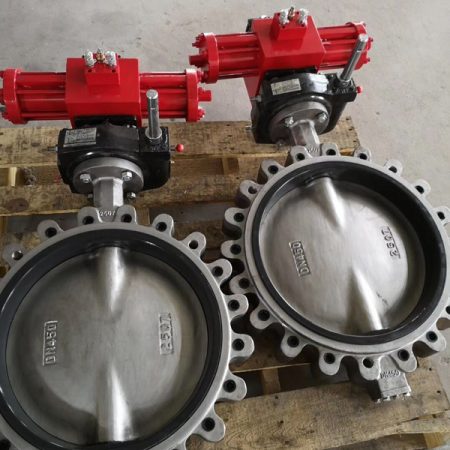
Recap of the main points discussed about the advantages of using lug and wafer butterfly valves.
To recap, this article has discussed the advantages of using lug vs wafer butterfly valve in fluid control systems. Wafer butterfly valves are a cost-effective and easy-to-install option due to their simple design and lightweight construction, making them ideal for low-pressure applications. Lug butterfly valves offer better support and stability in high-pressure applications, particularly in critical operations. They also allow for maintenance or repair of specific sections without shutting down the entire operation, adding to their versatility. Both types of valves have low maintenance requirements due to their simple design and few moving parts. Ultimately, the choice between these two types of valves depends on specific system requirements, including pressure, temperature, flow rate, space limitations, and budget constraints. Consulting with a fluid control system specialist can help determine the best valve type for a particular application. Choosing the right valve type is essential for maintaining optimal performance, efficiency, and reliability in fluid control systems.


